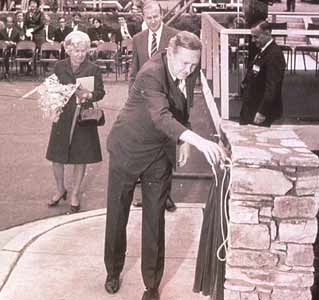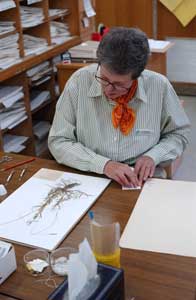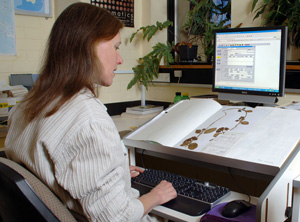History of the Gardens
Chronology
Administration
Directors
Logo
CSIRO and ANBG
Herbarium
Jervis Bay annex
Dickson Report 1935 (PDF version)
Oral History
Memorials
Miscellaneous - a range of documents that throw light on our history
History of the Gardens – decade by decade
1930s
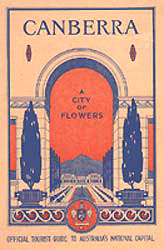 Canberra - City of Flowers - without a botanic garden
Canberra - City of Flowers - without a botanic garden
In the 1930s Canberra was known as 'A City of Flowers' in the official tourist guide, but it did not have a botanic gardens. In 1933 there was unanimous support from the Advisory Council that a start be made on laying out the botanic gardens. It was to be close to the proposed university with a scientific basis, rather than "for ornamental purposes only".
Dr B.T. Dickson, then Chief of Plant Industry in what was to become the CSIRO was asked to look at the feasibility of establishing a Gardens and choosing its site. For more than a year Dickson gathered information from botanic gardens around the world, and in September 1935 he presented his Report to the Advisory Council. As well as recommending the present site he suggested "stables, if horse-drawn instead of motor driven machinery is used" and a staff of 59 (which included an aviary keeper) which would cost the government £12,000 per year.
No action on establishing the Gardens was to take place for another ten years, till after the war.
In 1944 a research forester from South Australia, Lindsay Pryor, was appointed Superintendent of Parks and Gardens for Canberra.
1940s
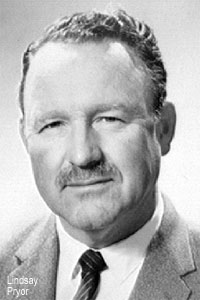 Starting a botanic gardens - the first few plantings
Starting a botanic gardens - the first few plantings
Three weeks after the war ended in 1945 Pryor sought a budget of £1,000 to start work on a botanic gardens. It was to be located on the lower slopes of Black Mountain as had been recommended in the Dickson Report ten years earlier. Over the next few years he started planting a range of eucalypts on the site.
In September 1949 an evening phone call from Pryor to Prime Minister Ben Chifley was all that it took to arrange the ceremonial planting of the 'first' trees. Two days later, during a visit by international foresters on 12 September, Chifley and the Director of Kew Gardens planted an oak and a eucalypt to celebrate the start of a botanic gardens for Canberra. The eucalypt planted on this occasion can be seen just inside the entrance gates of the Gardens.
1950s
The Botanic Gardens takes shape
 |
During the 1950s Lindsay Pryor set the scientific foundation for the botanic gardens by employing a European Professor of Botany, Erwin Gauba, as its first botanist. Gauba established the Gardens' herbarium of pressed plant specimens.
Eviction notices were sent to the lease holders who operated dairy farms on the slopes of Black Mountain, and the boundaries for the Gardens were surveyed and approved. (map)
Extensive contour ploughing was undertaken for water conservation. These contours later formed the basis for the paths in the lower parts of the Gardens.
Two annexes to the Gardens were established to increase the range of plants that could be grown. One was at Jervis Bay in a frost-free location on the south coast, and the other was an Alpine Annexe at Mt Gingera in the Brindabella Ranges.
Initially the horticultural activities were undertaken by staff from Yarralumla Nursery, but in 1956 Stan Kirby was appointed as the Gardens first full time overseer.
In 1958 Pryor was appointed Professor of Botany at ANU and David Shoobridge took over as Director of Parks and Gardens.
1960s
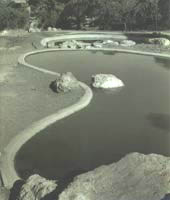 Pools near the present Cafe were built in 1967 |
 The Herbarium was located beneath the raised roof at the far end of the building, admin offices and a display room were at this end. (1967) |
The Botanic Gardens opens to the public
The 1960s saw the major development of the Gardens as they are today.
In 1960 Dr Betty Phillips was appointed botanist for the Gardens following her years as ecologist with the Snowy Mountains Hydroelectric Authority. She established the strong linkage between the living plants in the Gardens and the pressed scientific herbarium specimens. This was unique for botanic gardens at that time.
During the 1960s there was an emphasis on field collecting with major trips of several months duration as far afield as Western Australia to ensure that the collection was truly 'national' in character.
The carpark was built and paths and bridges were put in the steep gullies. Buildings were constructed for the Herbarium and administration, and the Nursery was established on its present site.
In 1967 John Wrigley was appointed Curator for the Gardens because of his background in growing native plants. By this time the Gardens had a staff of 33.
Later in 1967 the Gardens were open to the public for the first time with interpretive signs placed along the paths to complement the extensive labelling of plants.
1970s
The Botanic Gardens officially opened
The 1970s saw the Botanic Gardens develop into one of Canberra's major national attractions.
In October 1970 the Gardens were officially opened by the Prime Minister, John Gorton. One of the guests at that ceremony was Dr Bertram Dickson who had written the report recommending establishment of the Gardens back in 1935.
During 1970 a misting system was installed in a dry gully near the car park. During this decade the careful selection of plants, along with the artificially increased humidity, saw the development of the Rainforest Gully as one of the Gardens major attractions. This was a significant horticultural achievement as well as raising public awareness about rainforests.
The Gardens set up a display room for educational exhibitions and established an education program for school students. The landmark series of annual booklets 'Growing Native Plants' commenced in 1971. A horticultural research laboratory was built and a new herbarium building was constructed above the car-park.
In 1978 the name was changed from Canberra Botanic Gardens to National Botanic Gardens in recognition of the national role of the institution, and in 1979 Dr Robert Boden was appointed as its first Director.
1980s
The Botanic Gardens focuses on its visitors
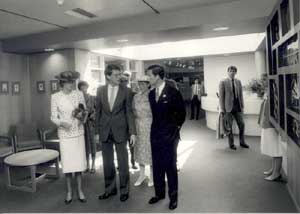 Diana, Princess of Wales with the Director, Dr Robert Boden, Anne Boden and Charles, Prince of Wales, at the opening of the Visitor Centre, November 1985 |
With the basic infrastructure of the Gardens established, the 1980s was a time to look after the visiting public.
In 1980 an amphitheatre was built in the Gardens as a memorial to Dr Nancy Burbidge who had died several years earlier. This became a popular venue for public functions and concerts, and later for weddings.
In 1982 special easy-access garden was opened for disabled people, together with an associated building and glasshouse for teaching horticultural skills. The Banks Centre still provides training for people with a wide range of abilities.
The pie-van that had operated for a couple of years was replaced by a café next to the Tasmanian section of the Rainforest Gully. This Café, now operated by Floresco, has proved a popular eating place since 1981.
In 1985 the Prince and Princess of Wales opened the present Visitor Centre with its exhibition area, Botanical Bookshop and a Public Reference Herbarium for visitors to identify their plant specimens.
Greater access was provided for visitors to the Rainforest Gully with board-walks constructed using government job creation schemes in 1983 and 1989.
In December 1989 the Gardens were nominated for National Estate listing.
1990s
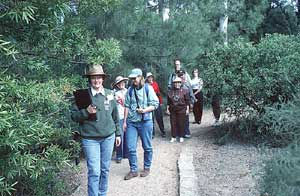 Volunteer Guides became a familiar sight around the Gardens in the 1990s. |
The Botanic Gardens focuses on the community
With the both infrastructure and visitor facilities established, the 1990s was a time for the Gardens to team up with both the general community and the scientific community.
After a public meeting in September, the Friends of the Botanic Gardens were officially launched by Professor Lindsay Pryor at a ceremony on 14 October 1990.
The launch of the Friends was part of a larger weekend community event, 'Biota 90', held jointly with CSIRO, involving behind-the-scenes access to research facilities and glasshouses.
The Gardens painted-all-over ACTION bus was launched in 1990, and could be seen travelling the streets of Canberra for almost 20 years.
In 1992 the first intake of volunteer guides undertook their extensive training course before starting a program of free daily guided tours that have continued ever since.
The Crosbie Morrison Centre for Environmental Education was opened in September 1992.
In 1993 the scientific research component of the Gardens united with those parts of CSIRO Plant Industry interested in native flora to form the jointly run Centre for Plant Biodiversity Research, combining the pressed plant collections of both institutions into one herbarium known as the Australian National Herbarium.
The community also became involved in a range of volunteer activities, including work in the Herbarium and Seed Store to promote the Gardens scientific role.
As the decade progressed more and more community activities were held at the Gardens, ranging from summer jazz concerts to the establishment of the Growing Friends plant propagation group and the Friends' Student Photographic competition.
A significant factor in making the work and knowledge of the Gardens accessable to the community was the establishment of the World Wide Web in 1993. The Gardens was the second web-site in Australia (after ANU) and quickly established a reputation for innovative ways to make our data publicly available, and for the size and scope of the website. [history]
2000s
The Botanic Gardens focuses on information
Consolidating on the Gardens' pioneering embrace of internet facilities like the World Wide Web in the early 1990s, the first decade of the 21st century saw the Gardens and its associated Herbarium become a hub for botanical and horticultural information.
In 2001 the Australian National Herbarium led the push for government support to database collection records for all the herbarium specimens in Australia under the auspices of the 'Australia's Virtual Herbarium' (AVH) project. This resulted in a government/private-sector program costing $10,000,000. The work was distributed among all the major herbaria and the goal was reached by the end of the decade. The general public and scientists had access to all this information via the web. [AVH link]
In 2001 the Gardens put the text of all its landmark 'Growing Native Plant' booklets from the 1970s on the web, updated and enhanced with more photographs. Participants in the Botanical Internship program then added profiles for further species year by year. [GNP link]
With the support of the Friends of the ANBG, the honorary Curator of Fungi, Heino Lepp, prepared a comprehensive website on the Fungi of Australia in 2003. This was followed later in the decade with ones on Bryophytes and then Lichens.
[links:
Fungi, Bryophytes, Lichens]
A major re-vamp of the Gardens photograph website saw the establishment of the 'Australian Plant Image Index' in 2004, and external funding enabled the Index to extend its scope to weeds and rainforest plants by the end of the decade. [link]
A novel way to disperse information about the Gardens and its collections to a new audience was the collaboration with the Gardens' first 'Artist in Residence', Julie Ryder, in 2004. She concentrated on artistic ways to interpret the cryptogam collections and the associated research.
In 2005 another national initiative by the Herbarium, with support from all the State herbaria, saw the start of the 'Australian Plant Census' (APC) to establish by consensus a listing of current names for every flowering plant in Australia. This too used the internet to make the information available to all. [link]
In 2008 the Gardens opened the Botanical Resource Centre, providing access to information to the general public with a Public Reference Herbarium, computers, and library, open seven days a week. A team of facilitators was trained to assist visitors with facilities such as interactive plant keys. [link]
![Director of National Parks [logo]](../../../images/dnp_90px.gif)







